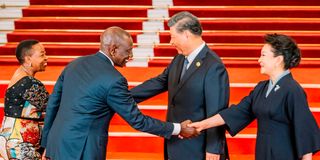President Ruto pitches for SGR linking African's east and Western coasts

President William Ruto and First Lady Rachel Ruto are received at the Great Hall of the People during a State banquet hosted by President Xi Jinping for visiting Heads of State and government in Beijing, China, on October 17, 2023.
What you need to know:
- President Ruto said he had held discussions with his peers in Uganda, the DR Congo and Congo-Brazzaville on extending the project from coast to coast.
- In August, Kenya and Uganda inked an agreement to jointly solicit for financiers to extend the SGR to Malaba and on to Kampala.
President William Ruto on Tuesday revealed that Africa was willing to expand cross-border infrastructure networks in a pitch to Chinese investors, while seeking to appeal to Beijing to consider extending the Standard Gauge Railway (SGR) beyond Kenya.
The President’s pitch was the clearest hint yet that Nairobi was seeking money to continue the Chinese-built SGR project that is currently stalled at Naivasha.
At an investment forum in Beijing, President Ruto said he had held discussions with his peers in Uganda, the Democratic Republic of Congo and Congo-Brazzaville on extending the project from coast to coast.
“It is because we want to connect the eastern coast of Africa to the western coast of Africa using the SGR,” he said at a Kenya-China forum organised by the Kenya Investment Authority, on the sidelines of the Third Forum on the Belt and Road Initiative.
“We have had conversations with the Presidents of Uganda (Yoweri Museveni), DRC (Felix Tshisekedi), and Congo-Brazzaville (Denis Sassou Nguesso) and have all agreed on the need to extend this important piece of infrastructure as a means of facilitating trade across our continent and making sure that companies like yourselves who set up in Kenya not only have access to the local market but also to East Africa and the rest of the continent.”
The President’s speech focused on how his administration was making it easier to for investors. But he was actually also assuring the Chinese of political willingness to support the SGR.
The discussions between the regional neighbours isn’t new.
In August, Kenya and Uganda inked an agreement to jointly solicit for financiers to extend the SGR to Malaba and on to Kampala, with the ultimate goal of reaching the Democratic Republic of Congo. But the issue of funding had derailed its targets. Kenya accrued some $4.5 billion (over Sh670 billion) in loans to build it from Mombasa to Naivasha.
And the Chinese dithered on funding it further after Uganda grew cold feet on signing on a new loan to extend it within its borders. For years, Beijing had always seen the SGR as crucial to boost trade by accessing raw materials and markets within Africa’s hinterlands. But its viability also depended on how other countries could buy in.
When they signed the deal in August, Kenya and Uganda didn’t mention specific countries targeted for talks on funding. But the ease of accessing the money was always going to count.
China has recently been amenable to public-private partnerships, which could allow Beijing to build the SGR and let operators recoup the money via charging transportation fees.
Yet Nairobi will still have to commit that the business of cargo transportation will be guaranteed. It will need security and political buy-in, which President Ruto pledged.
“Our solid track-record of a friendly business environment, broad trade opportunities, good infrastructure and wide pool of skilled manpower guarantees investors a high return on their investments. Kenya is ready for business,” he said.
“Its strategic location, rich history of stability and overly revolutionary technology have turned the country into one of the world’s top investment spots.”





